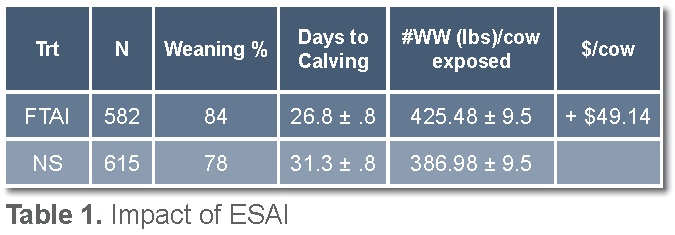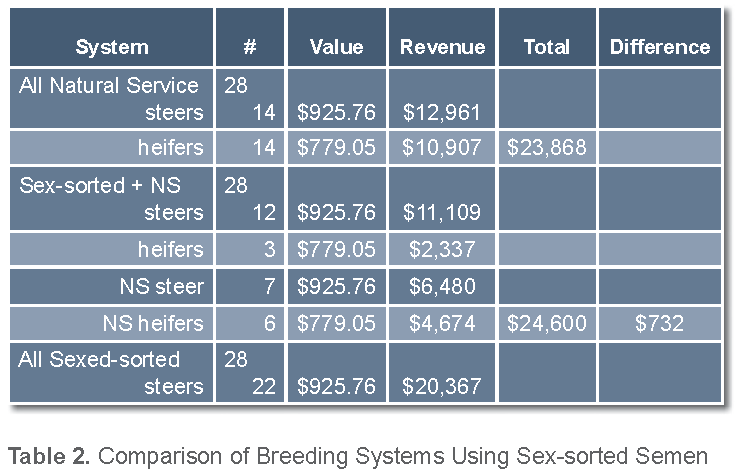Dr. Les Anderson, University of Kentucky
The easiest road to maximum breeding efficiency in the beef cow-calf industry is through estrous synchronization and AI (ESAI). Estrous synchronization helps shorten the calving season, increases herd pregnancy rates, and helps increase calf uniformity and weight (calves are typically older).
Use of ESAI can improve productivity and revenue. Recent research from Dr. Cliff Lamb examined the short-term economic impact of a breeding system that included FTAI + natural service or just natural service in about 1,200 females on 8 different farms (Table 1).[1] The breeding seasons began and ended on the same day in both groups on all farms. A partial budget was used to compare the positive economic impact (added revenue, reduced costs) with the negative economic impact (added costs, reduced revenue). Use of ESAI improved short-term returns by about $50 per cow. 
At the same age, steers typically weigh more and generate $146.71/hd more revenue. Sex-sorted semen has been available for several years and is used most often in the dairy and beef seedstock industries. Conception rate of sex-sorted semen was initially too low for most cattlemen to consider, but the sorting/freezing process has improved considerably, and now conception rates are basically similar to conventionally-frozen semen. Male-sorted beef semen normally costs about the same as conventional, but female-sorted beef semen is about 50% more expensive ($25 conventional = $40 female sorted). Does the additional value of gender control pay for the added costs? In a typical 30-cow herd, 14 steers and 14 heifers might be weaned (93% weaning rate). Using the values in Table 2, the steers would be worth $12,961, while the heifers would be worth $10,907. Let’s assume that we implement an ESAI system AI using sex-sorted semen and a 50% conception rate to AI. We breed 6 cows to female-sorted semen and 24 to male-sorted semen. We can either use natural service to clean up or shift to a total AI system. Both systems are illustrated.
Shifting from natural service to an ESAI system has been shown to increase short-term revenue by about $50 per head. Shifting gender adds $24-37 more revenue per head, making the shift to ESAI even more attractive. Revenue can be even higher if the producer selects carcass-oriented genetics, ownership is retained, and the steers are fed to hit a high-value grid. Six females will be inseminated using female-sorted semen, but that will only increase the cost about 10% overall. Long-term, using maternally-oriented genetics on your top cows should increase maternal performance. Controlling gender offers exciting opportunities for all cattlemen to take their operations to the next level.
[1] Rogers et al. 2012. An economic evaluation of estrous synchronization and timed artificial insemination in suckled beef cows. J. Anim. Sci. 90:4055-4062. doi:10.2527/jas.2011-4836
Source: Ohio Beef Cattle Letter



Leave A Comment